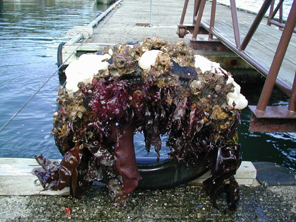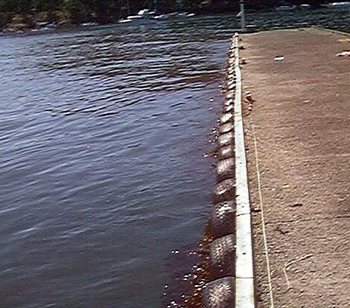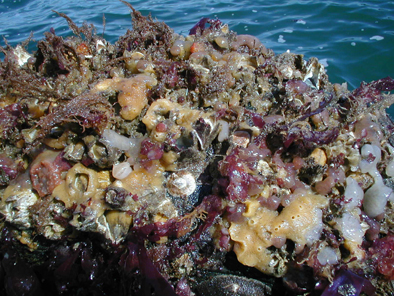
Introduction
Barnacles, mussels, sponges, and other ╬fouling organismsÔ may be unwelcome guests when they colonize the hulls of boats, but on floating docks they can present both the aspiring student and the seasoned marine biologist with a fascinating array of diversity. Floating docks are common, albeit artificial, marine habitats on many coastlines, and offer the advantage of easy access to a wide variety of marine life without the need for boats or diving equipment. As part of a summer course in marine invertebrate zoology, we undertook a study of the floating dock in front of Friday Harbor Labs (FHL), San Juan Island, WA (USA) to characterize the rich marine communities found there and attempt to understand how they are structured by the unique physical parameters of their environment.
 The
floating dock examined in this study is lined with tires, as is common
practice in places where boats may be moored. The tires are attached to
the dock by their top surface only, which facilitated easy inspection by
a process of flipping them out of the water into an upside-down position.
This portion of the FHL dock is orientated with its long axis parallel
to shore. One half of the dock (╬outsideÔ) is therefore exposed to incident
waves, and the other half (╬insideÔ) is more sheltered from such disturbances.
The
floating dock examined in this study is lined with tires, as is common
practice in places where boats may be moored. The tires are attached to
the dock by their top surface only, which facilitated easy inspection by
a process of flipping them out of the water into an upside-down position.
This portion of the FHL dock is orientated with its long axis parallel
to shore. One half of the dock (╬outsideÔ) is therefore exposed to incident
waves, and the other half (╬insideÔ) is more sheltered from such disturbances.
Floating docks provide
a unique biological habitat because, unlike pilings or other fixed structures,
their surfaces rise and fall with the tide. They therefore provide a habitat
very near the surface for benthic sub-tidal species that normally live
only at much greater depths. This gives the habitat a constancy in most
physical conditions that is in great contrast with intertidal habitats,
which are cyclically exposed to air and then water as tides ebb and flow
(see pages on Cattle
Point, Argyle Creek and False
Bay). It is important to understand the nature of these physical conditions,
for they determine the sorts of organisms that can live on docks and in
other habitats.
Temperature: Temperatures fluctuate very little in the surface water surrounding most floating docks. We recorded the temperature continuously for two days on tires both on the inside and outside sections of the FHL dock. Temperature averaged ~11°C, with a diurnal variation of only ~2°C.The first four parameters (temperature, light, salinity and space) change little from day to day on any given tire that lines a floating dock. Current velocity, however, may differ markedly on opposite sides of a dock. Some organisms are affected by this difference, and some are not. An attempt was made to quantify the relative difference in shear velocity between the inside and outside of the FHL floating dock using dissolution rates of Life SaversTM.Light: Marine organisms living on floating docks are necessarily living very near the surface, and therefore receive a large amount of light. Many species of algae take advantage of this resource, and colonize tires in dense mats.
Salinity: Salinity varies little in the water surrounding most floating docks, unless of course there is a nearby freshwater stream. Water near the surface is constantly refreshed by local currents and there is no opportunity for evaporation or other processes to create local differences in salinity.
Space: Plants and sedentary animals need a surface to which they can attach themselves. Tires on floating docks are often densely packed with organisms which must compete with each other for space if they wish to grow or recruit. On the tires, space is the ultimate limiting resource. Unlike some other habitats (e.g. False Bay), no appreciable sediment accumulates on the surfaces of floating docks, so burrowing organisms are largely absent.
Hydrodynamic Conditions and Disturbances: Alternate sides of floating docks are often differentially exposed to currents and waves. While faster currents may bring more planktonic food to filter-feeding animals on the tires, excessive wave action may make it difficult for some organisms to remain attached to their substrate. In addition, boats and various other human disturbances may occasionally impact the habitat.

We surveyed organisms on five inside and five outside tires on the Friday Harbor Labs floating dock. For a complete list of the most common organisms found and their abundances, click here. Many species are apparently unaffected by current flow, and are common on both the inside and the outside tires. Abundant algae include sea lettuce (Ulva fenestrata), Turkish towel (Mastocarpus papillatus), and Porphyra sp., which looks like red cellophane. Encrusting bryozoans like Membranipora membranacea adorn much of the algae on the tires, whereas other encrusters prefer the rubber itself as a substrate. Dendrobeania lichenoides, an erect bryozoan which, when numerous, looks like clusters of small potato chips, is also common. A yellow sponge with the texture of bread crumbs called Halichondria bowerbanki is ubiquitous. Distaplia occidentalis, a colonial sea squirt that looks like a bouquet of flowers if one squints hard, is the most common ascidian. Another ascidian evident on many of the tires is Aplidium spp., which is a sheet-like, tan or white colored colonial tunicate that can grow to cover other tire-dwellers. It's hard to miss Boltenia villosa, which is a tunicate that looks like a small, ripe strawberry. The arthropods are represented on virtually every tire by various species of crab, amphipod, and isopod. Our surveys often uncovered numerous Cancer oregonensis crabs, as well as decorator crabs adorned with bits of algae or bryozoans. Sabellid worms are common tire denizens. When a tire is lifted out of the water, these worms quickly retreat into their leathery tubes, which fold and roll shut like a party favor noisemaker. Common molluscs on the tires include several species of chiton, limpets, and Lacuna vincta, a small, brown, unassuming snail.
The significant difference in water flow between the inside and outside portions of the dock, as demonstrated by our Life Saver dissolution experiments, is correlated with both species composition and abundance on the tires. A few species are found almost exclusively on either the inside or the outside tires; others, though common on all tires, are much more numerous on one side than the other. On the inside tires, where shear velocity is relatively low, the sea anemone Metridium senile and the ascidians Chelyosoma productum and Distaplia occidentalis are significantly more abundant than that on the outside tires. The alga Laminaria saccharina and various species of encrusting bryozoans were found solely on inside tires. These organisms may occur more frequently on the inside tires for a number of different reasons, including delicate body form or relatively weak substrate attachment, both of which might preclude them from withstanding the higher shear velocities found around the outside tires. They might, in addition, be able to make due with the lower plankton (i.e. food) flux rates that go along with reduced fluid flow around the inside tires and thus compete better for space than species that require a larger food input.
The species that were significantly more abundant on the outside tires include the large barnacle Balanus nubulis, the mussel Mytilus edulis, the limpet Collisella pelta, the hydroid Plumularia setacea and the alga Alaria marginata. The barnacles, mussels and limpets are all encased within a hard outer skeleton or shell, which probably helps to protect their soft parts from the higher shear velocities that prevail around the outside tires. They are also very firmly attached to the tires¸ it is virtually impossible to pry these organisms off of the substrate without using some kind of tool. The armored animals fare very well in the higher energy conditions and seem to thrive in the higher shear velocity regimes that bring in a greater food flux.
Having surveyed the biological diversity on the FHL floating dock tires, we became interested in how the organisms that live on the tires make their living. Addressing this question involved taking a closer look at four main themes: Feeding, Reproduction, Locomotion and Protection.
The tires on the Friday Harbor Lab floating docks host an impressively rich diversity and abundance of marine invertebrates and constitute a unique community in which space is the ultimate limiting resource. The float communities offer the convenient opportunity to examine the lifestyles of and interactions among many shallow marine inhabitants. On the tires, organisms that are typically found in subtidal environments or in the ever-changing intertidal zone have the luxury of living in a relatively constant,very shallow marine environment. Environmental parameters, such as temperature, salinity and light intensity, remain essentially unchanged within this habitat. Hydrodynamic differences within the small area of the docks appear to be the only significant environmental variation. Documentation of the relative shear velocities on either side of the dock helped us to understand distribution and abundance patterns of the floating dock communities. In general, organisms that are well-suited (i.e.,have exoskeletons such as Balanus nubulis) for higher energy conditions are found in greater abundance on the outside/more exposed portion of the dock, whereas animals with more delicate body structures (e.g. Metridium senile) appear in greater number on the less-exposed inside tires.
This web page is the product of a Marine Invertebrate Zoology class research project which aimed to survey the biological diversity of the FHL floating docks and understand how the tire communities are affected by the physical parameters of their unique environment. Numerous research ideas arose as a result of this time-constrained project. Below is a summary of some of those ideas and the questions that arose along with them.
Interesting questions and ideas generated by the project:
Settlement rates and patterns: It would be interesting to attach various pristine materials (e.g. wood, Plexiglas, a fresh piece of tire) on the floats to document rates of larval settlement and to record possible patterns of succession on the tires as well as on other types of human-made substrate. Are there recognizable settlement patterns on the tires (who settles first, etc.)? How do settlement patterns differ among different substrate materials?
Seasonality: Some of the biological components of the float communities (particularly certain algae, such as Laminaria saccharina) are seasonal. What seasonal changes occur within the community and how does the loss of certain key taxa affect the distribution and relative abundances of other members of the float community?
Dock Position/Orientation: The dock we studied at FHL is oriented parallel to shore. Other docks in the vicinity are arranged in different positions relative to the currents. How do the diversity, relative abundances and distribution of organisms within the float communities on those docks compare to those of the examined area?
Tidal Influences: As previously mentioned, the floating dock communities "move with" the tide and are therefore not greatly influenced by tidal variations, unlike many other shallow marine communities (see Argyle Creek, Cattle Point and False Bay). As part of this project we measured Life Saver dissolution rates to get an idea of relative shear velocities so that we might better understand the effects of water flow on either side of the floating dock. These measurements were made on one morning as the tide was going out. It would be interesting to do a more precise and intensive study of the effects of fluid flow on the structure of this floating dock community.
This web page was designed for those interested in exploring the biological world of floating docks and pilings. For a general lesson plan and further suggestions, click here.

This page is the product
of a Marine Invertebrate Zoology class project which examined the floating
docks at the Friday Harbor Laboratories on San Juan Island, WA. It was
completed in June 2000 by, clockwise from left, Amrita de Zoysa, Heather
Moffat, Dan Neafsey and Simone Francis.
Acknowledgments
We would like to thank the professors of the summer 2000
FHL Marine Invertebrate Zoology course, Mike
Hart and Bob Podolsky and the T.A.s, Marney
Pratt and Russell Wyeth, for their assistance and patience during the
making of this masterpiece.
References and Suggested Further Reading:
Behrens, D.W., 1991. 2nd edition. Pacific Coast Nudibranchs, Sea Challengers. Monterey, CA, 107 p.
Jensen, G.C., 1995. Pacific Coast Crabs and Shrimps, Sea Challengers, Monterey, CA, 87 p.
Kozloff, E.N., 1993. Seashore Life of the Northern Pacific Coast, University of Washington Press, Seattle and London, 370 p.
Ricketts, E.W., Calvin, J. and Hedgpeth, J.W., 1985. 5th edition. Between Pacific Tides, revised by D.W. Phillips, Stanford University Press, 652 p.
Schabes, M., 1990. Needles and candy: assessing the variation in the local boundary layer characteristics over the thallus of Alaria marginata and its implications on the epiphytic communities, Physical Biology (Zool. 533D) Coursebook, University of Washington, Friday Harbor Laboratories, Summer 1990.
Strathmann, M.F., 1987.
Reproduction and Development of Marine Invertebrates of the Northern Pacific
Coast, University of Washington Press, 670 p.
Links to Additional Floating Dock/Wharf Pilings-Related Sites:
Educational Workshop on Dock/Wharf Habitats
University
of Georgia (Griffin Campus) Teacher's Corner
Sites on Wharf/Dock Habitats:
Reef and Pilings Habitats, Monterey Bay Aquarium
Marin
Academy's Oceanography Class Page (San Rafael, CA)
Links to Other FHL-Documented Habitats on San Juan Island: